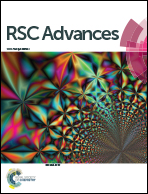Computational insights into different inhibition modes of the κ-opioid receptor with antagonists LY2456302 and JDTic†
Abstract
In drug design and discovery, ligand binding kinetics combines pharmacokinetics and pharmacodynamics and more and more attention is paid to it. The κ-opioid G-protein coupled receptor (κ-OR) has been determined to be a promising drug target for the treatment of depression- and anxiety-related diseases. Among the κ-OR selective antagonists, JDTic is a failed antidepressant with a short drug-target residence time (RT), whereas LY2456302 exhibits better effects with a longer RT than JDTic. To investigate the inhibition mechanism of the κ-OR induced by the two ligands, unbiased molecular dynamics and well-tempered metadynamics simulations were performed on JDTic–κ-OR and LY2456302–κ-OR complexes. Through detailed analyses of the simulations, a strong but single interaction mode was found to be responsible for the adverse effects and short RT of JDTic, which could be considered as an alert for other chemotypes, whereas LY2456302 was more advanced, mainly due to its multiple metastable states. Based on Eyring’s equation, the relative RT of LY2456302/JDTic, determined from the activation free energy of dissociation ΔG≠off, was efficiently calculated and was in good agreement with experimental data. Thus, these simulations might be helpful for the further design of antidepressants targeting κ-OR with reasonable RT.


 Please wait while we load your content...
Please wait while we load your content...